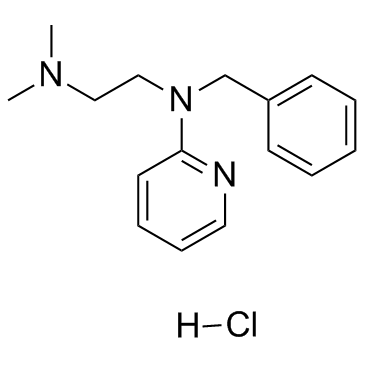H1-receptor antagonist, tripelennamine, does not affect arterial hypoxemia in exercising Thoroughbreds.
Murli Manohar, Thomas E Goetz, Sarah Humphrey, Tracy Depuy
文献索引:J. Appl. Physiol. 92(4) , 1515-23, (2002)
全文:HTML全文
摘要
It has been suggested that pulmonary injury and inflammation-induced histamine release from airway mast cells may contribute to exercise-induced arterial hypoxemia (EIAH). Because stress failure of pulmonary capillaries and EIAH are routinely observed in exercising horses, we examined whether preexercise administration of an H1-receptor antagonist may mitigate EIAH. Two sets of experiments, placebo (saline) and antihistaminic (tripelennamine HCl at 1.10 mg/kg iv, 15 min preexercise) studies, were carried out on seven healthy, exercise-trained Thoroughbred horses in random order 7 days apart. Arterial and mixed venous blood-gas and pH measurements were made at rest before and after saline or drug administration and during incremental exercise leading to maximal exertion at 14 m/s on 3.5% uphill grade for 120 s. Galloping at this workload elicited maximal heart rate and induced exercise-induced pulmonary hemorrhage in all horses in both treatments, thereby indicating that capillary stress failure-related pulmonary injury had occurred. In both treatments, EIAH, desaturation of hemoglobin, hypercapnia, and acidosis of a similar magnitude developed during maximal exertion, and statistically significant differences between the placebo and antihistaminic studies could not be demonstrated. The failure of the H1-receptor antagonist to modify EIAH significantly suggests that pulmonary injury-induced histamine release may not play a major role in bringing about EIAH in Thoroughbred horses.
相关化合物
| 结构式 | 名称/CAS号 | 分子式 | 全部文献 |
|---|---|---|---|
 |
盐酸曲吡那敏
CAS:154-69-8 |
C16H22ClN3 |
|
Translating clinical findings into knowledge in drug safety ...
2011-12-01 [J. Sci. Ind. Res. 65(10) , 808, (2006)] |
|
Developing structure-activity relationships for the predicti...
2010-07-19 [Chem. Res. Toxicol. 23 , 1215-22, (2010)] |
|
A predictive ligand-based Bayesian model for human drug-indu...
2010-12-01 [Drug Metab. Dispos. 38 , 2302-8, (2010)] |
|
Determination of antihistamines based on the formation of mi...
1998-05-01 [Analyst 123(5) , 1079-84, (1998)] |
|
Role of N-methyl-D-aspartate receptors in gastric mucosal bl...
2004-09-01 [J. Neurosci. Res. 77 , 730-738, (2004)] |